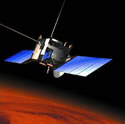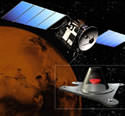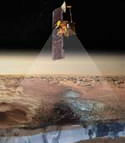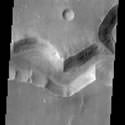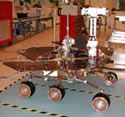
Image credit: NASA
With only a few months to go before NASA launches its next two rovers to Mars, mission planners need to pin down exactly where they want the robot explorers to touch down. The twin Mars Exploration Rovers are scheduled for launch in May and June of 2003, and they currently have four candidate landing locations picked out – each of which offers unique terrain to explore. The final decision will be made in April.
The launch dates for the two Mars Exploration Rovers are getting closer and so is the need to pick a place for them to land.
Adventurous travelers might spin a globe and pick a vacation based on whichever spot their finger finds. But scientists and engineers working on NASA’s newest rover mission cannot be as casual about landing site choices for the twin rovers that will launch in May and June of this year.
Last week, team members and others from the scientific community met for a final chance to discuss and fine-tune the pros and cons of each of the four landing site contenders.
Images and data from two other NASA spacecraft currently orbiting the red planet — Mars Global Surveyor and Mars Odyssey — have provided invaluable information on possible landing sites.
“This is a unique period where we have orbital missions that can help us make the selection,” said Dr. Matt Golombek, JPL landing site scientist. “We want to go to sites with terrains that will challenge our minds but not the safety of the rovers.”
Since the rovers do not have the luxury of landing on a well-paved runway, JPL geologists and engineers must carefully choose an area without large rocks that could damage the rovers’ airbag landing system. Also, an area that is too densely populated with rocks of any size could prevent the rover from moving freely. Winds in the lower atmosphere are also an important consideration, as are the slopes the airbag-clad lander impact against.
Adequate exposure to the sun is vital for the solar-powered rovers. Geologists have chosen sites near the equator where there is sufficient sunlight. The sites are also relatively free of accumulations of iron-oxide dust particles that can coat solar panels and interfere with the rovers’ mobility.
Like the final four in any competition, each of the four Mars candidates is a potential winner.
“Three of the sites, Terra Meridiani, known as the Hematite site, Gusev, and Isidis show evidence for surface processes involving water. These sites appear capable of addressing the science objectives of the rover missions: to determine if water was present on Mars and whether there are conditions favorable to the preservation of evidence for ancient life,” said Golombek.
The fourth site, Elysium, appears to contain ancient terrain, which may hold clues to Mars’ early climate when conditions may have been wetter.
Over the next several months, geologists and engineers will continue to analyze the viability of each site. The final decision will be made by NASA in April, shortly before the rovers begin their journey to Mars.
Original Source: NASA/JPL News Release

